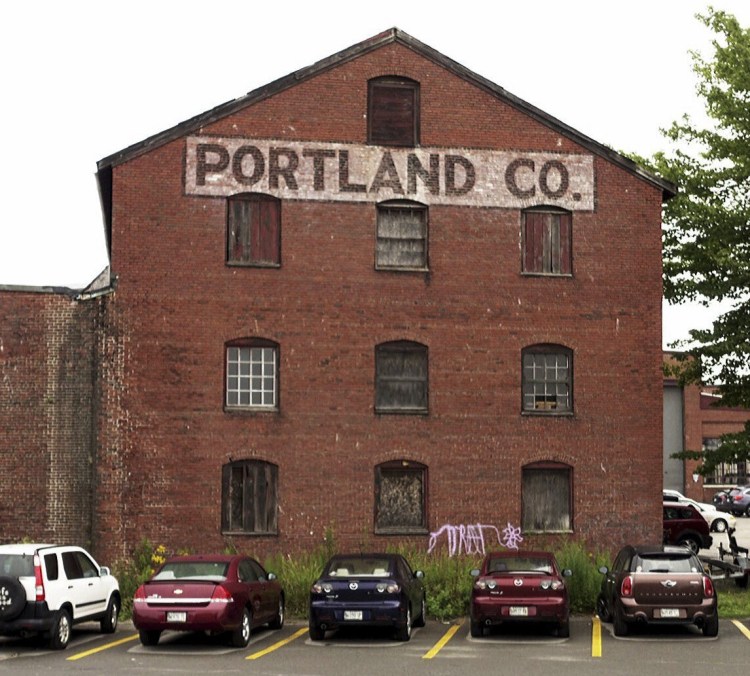The developers of the former Portland Co. site on the city’s eastern waterfront received approvals last week to dismantle and rebuild a historic brick building that they had originally planned to move in one piece. It could be the first time a historic brick building has been taken apart and reconstructed in Maine, according to preservationists.
The city’s Historic Preservation Board approved the plan for the Pattern Storehouse at 58 Fore St. on Wednesday. A city official said the vote clears the way for Portland Foreside Development Co. to pull demolition permits in the coming months to dismantle the building and clear a handful of other buildings that won’t be preserved.
Deb Andrews, the city’s historic preservation manager, said the board allowed the developers to dismantle and reconstruct the circa 1895 building after an engineer determined that moving it would cause too much damage. Andrews said crews plan to dismantle and document the building brick by brick, so it can be rebuilt to its original form.
“It’s not a treatment you land on without serious evaluation and consideration, but in this case it seems to be the appropriate treatment for this building,” Andrews said.
Such a drastic measure to preserve a historic brick building is rare – if not unprecedented – in Maine.
“It’s not something we’ve ever encountered,” said Christi Mitchell, assistant director of the Maine Historic Preservation Commission, after conferring with others in her office.
Julie Larry, advocacy director of Greater Portland Landmarks, a nonprofit preservation group, said it is unfortunate that the building has deteriorated to the point that it could not be moved as a whole. But she is pleased it will remain on site to help tell the story of the former manufacturing complex.
Larry said the Secretary of the Interior’s Standards for the Treatment of Historic Properties have four categories of best practices: preservation, rehabilitation, restoration and reconstruction. She couldn’t think of another example of a brick building being taken apart and rebuilt.
“Moved buildings are not that unusual, but re-created buildings are pretty rare, (and) they are indeed considered historic,” said Larry, noting that the only other example she could think of was Fort Halifax, a wooden building in Winslow that was rebuilt in the 1980s after a flood.
Andrews said the building will have to be fully reconstructed before the city will issue a certificate of occupancy for a proposed office building on the site.
Kevin Costello, a principal of the Portland Foreside Development Co., did not respond to requests for comment Thursday or Friday about when the demolition permits would be pulled, or when plans for a new office building would be submitted. But Andrews said the development team indicated that the demolition permits would be pulled in the next few months.
That means demolition could begin this spring, or summer, just as a new 150-slip marina opens up on-site. The marina and demolition work would be the first visible signs that an ambitious redevelopment plan for the 10-acre site is moving forward.
The master plan for redevelopment approved in December 2016 calls for a mix of housing, office, retail, hotel rooms, structured parking and a marina. Forty-three percent of the site has been designated as a historic district, because of its history as a former railroad foundry. And eight out of 16 buildings are due to be preserved.
The Pattern Storehouse, a 3½-story brick building with a gabled roof and the words “Portland Co.” scrawled across the top, dates back to when the site was a railroad foundry.
Founded in 1846, the Portland Co. complex was built to connect Portland to Montreal by rail and was the first locomotive factory in the United States that brought all of the necessary shops and foundry together on one site. It remained in operation for 137 years and was deemed eligible for the National Register of Historic Places in 1976.
Built in 1895, the storehouse was located away from the core of foundry buildings because flammable materials were stored there. The interior is divided into three main floors with wood-planked flooring and exposed brick walls and wood framing.
The building is being relocated to make way for a new office building. Andrews said the storehouse will be rebuilt closer to the waterfront. It will be separated from the new office building by an access drive into the site.
The storehouse is currently connected to another building, which was deemed a noncontributing structure to the historic district. Once they are separated, Andrews said the developer will be able to “interpret” the final design for the open side, facing the mainland. The final design would need the board’s approval, she said.
Renderings showed glass garage door-type walls facing the ocean, but Andrews said the board did not want developers to reorient the building, so the plan was dropped.
“To turn it around is really a false sense of history,” she said. “The board felt that it was important to maintain that historic relationship.”
Randy Billings can be contacted at 791-6346 or at:
rbillings@pressherald.com
Twitter: randybillings
Send questions/comments to the editors.




Success. Please wait for the page to reload. If the page does not reload within 5 seconds, please refresh the page.
Enter your email and password to access comments.
Hi, to comment on stories you must . This profile is in addition to your subscription and website login.
Already have a commenting profile? .
Invalid username/password.
Please check your email to confirm and complete your registration.
Only subscribers are eligible to post comments. Please subscribe or login first for digital access. Here’s why.
Use the form below to reset your password. When you've submitted your account email, we will send an email with a reset code.